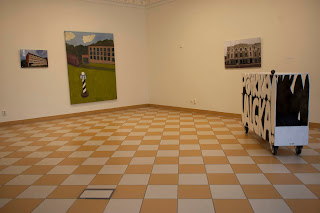MAZPILSĒTA KĀ NOTIKUMS
Rait Rosin izstāde
07.08. - 31.08. Valgas Muzejā
Mazpilsētās mīt svarīgi cilvēki. Mēs visi esam uzmanības vērti, pat ja tās dažkārt šķiet par daudz. Izstādē aplūkots stāvoklis divās mazpilsētās – Valgā un Veru. No vienas puses, šo pilsētu iedzīvotāji dalīsies domās par māksliniekiem, kas viņu pilsētās viesojas. No otras puses, 10 izvēlēti mākslinieki organizēs atvērtus pasākumus. Izstādes laikā Rait Rosin un viņa asistenti ar īpašu ripojošu kasti pārvietosies pa Valgu un Valku, atverot centrālos laukumus un izpētot vairāk vai mazāk neiepazītas vietas pilsētas apkaimē. Šo ceļojumu laikā tiks intervēti vietējie iedzīvotāji. Izstādei Augustā sekos dažādi kultūras pasākumi, to norises laiki tiks izziņoti vēlāk.
Intervijas veido nesakritības un pārklājumi starp mākslas publikas ekspektācijām un mākslinieka idejām. Kamēr mākslinieki savus nolūkus izsaka ar kontekstu un mākslu, publika sakopo savus uzskatus par izstādēm un atspoguļo patiesās problēmas sabiedrībā. Tas, kas īsti notiek mākslas izstādē, tai paliks sekundārs. Šīs divas pozīcijas, kas izvērtē radošo darbu kā kulturālu aktivitāti, parādās perifēras mākslas sociālajā iedarbībā. Sociālā un kultūras vide ir atšķirīga abās pilsētās, kas atrodas vienā kultūras telpā, bet dažādās ģeogrāfiskās vietās.
Rait Rosin konceptualizē no sarunas ar iedzīvotājiem izrietošos problēmjautājumus. Kā saka viņš pats, māksliniekiem vajadzētu būt par vidutāju un skaidrot šādus jautājumus kā realitāšu ģenealoģiju. Šādas radošās aktivitātes darbojas kā sākumpunkts sabiedriskai diskusijai mazpilsētās. Ar mākslu saistītās ekspektācijas un to atbilstība ir apspriestas līdztekus radošajām pozīcijām sabiedrībā. Mazpilsētās mākslai ir īpaša loma. Perifēras idejas izpaustas caur radošām izvēlēm, lai uz sevišķu notikumu pamata veiktu vispārinājumus. Dalījums perifērijā un centrā norāda uz dalītu uzmanību sabiedrībā, kur konkrētas vietas gūst vispārēju un tipisku raksturu. Tas nosaka, vai mazpilsēta iekļūs mediju redzeslokā vai paliks vietējas nozīmes ierobežota. Rait Rosin līdzīgu pētījumu iepriekš veicis Paldiski un Haapsalu.
Izstādi atbalsta Igaunijas Laikmetīgās Mākslas centrs un tā simtgades svētku mākslas programma “Atnācēji, aizgājēji un palicēji – Igaunijas kopienu vēstures”, kā arī Igaunijas Kultūrkapitāls.
Izstāde atvērta no 7. līdz 31. augustam.
Darba laiks: no otrdienas līdz piektdienai 11.00-18.00, sestdienās 10.00-15.00































































